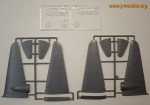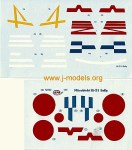
De un vistazo – Quick look
MATERIAL Y PIEZAS
MEDIA & PARTS:
- Plástico inyectado (50 piezas), resina (27 piezas) y 7 piezas transparentes.
- Injected moulded styrene (50 parts), resin (27 parts) and 7 clear parts.
CALCAS – DECALS:
- Muy buenas. Registro e impresión correctos. Colores excelentes.
- Very good. Correct register and printing. Fine colours.
OPCIONES – OPTIONS:
- Ki-21-Ib: • 12º Sentai, China, finales 1942. •60º Sentai, China.
Ki-21-IIb: • 14º Sentai, Wewak (Nueva Guinea), 1943. •8º Hiko Shidan, Sentai Hombu, Taiwan, 1944-45. •12º Sentai. • 60º Sentai, Nueva Guinea, 1944. • 98º Sentai, Birmania, 1943. - Ki-21-Ib: • 12th Sentai, China, late 1942. •60th Sentai, China.
Ki-21-IIb: • 14th Sentai, Wewak (New Guinea), 1943. • 8th Hiko Shidan, Sentai Hombu, Taiwan, 1944-45. • 12th Sentai. • 60th Sentai, New Guinea, 1944. •98th Sentai, Burma, 1943.
INSTRUCCIONES – INSTRUCTIONS:
- Libreto de 12 páginas que incluye resumen histórico multilingüe, diagrama de piezas, montaje, guía de colores y opciones de pintura en la gama de colores de Humbrol.
- 12-page booklet including multilingual historical summary, parts plan, assembly steps, colour guide and painting options. Paint codes are referred to Humbrol range.
LO MEJOR – THE BEST:
- Posibilidad de montar los modelos Ib o IIb. Formas generales correctas. Variedad de calcas en color. Piezas de resina. Pozos del tren detallados.
- Choice to build either Ib or IIb model. Generally accurate shape. Lots of colourful decal options. Resin parts. Detailed wheel wells.
LO PEOR – THE WORST:
- Marcas de eyector en algunas zonas internas. Transparente de la carlinga incorrecto. Encaje de alas y fuselaje aparentemente débil. Precio.
- Ejector pins on the inner sides of wings and fuselage. Inaccurate cockpit canopy. Wings and fuselage fit apparently weak. Price.
VALORACIÓN – CONCLUSION:
- Maqueta versátil. Como en el modelo anterior del Ki-21, los extras en resina, calcas y la posibilidad de escoger entre dos modelos compensan el precio y algunos errores. Recomendada para modelistas con experiencia.
- Versatile kit. As in the other MPM Ki-21 kit, resin parts, decals and the choice between two models are worth the price and some inaccuracies. Recommended to experienced modelers.

Esta segunda maqueta de MPM dedicada al Mitsubishi Ki-21 es en su mayor parte idéntica a la primera [ver revisión], con la que comparte molde. Incluye algunas piezas más en plástico y resina, pero no las mascarillas de Eduard y sólo una hoja de calcas. Si en la ocasión anterior podía construirse un Modelo II, en esta se puede montar bien un Modelo Ib o bien IIa/IIb. En consecuencia, esta segunda entrega permite montar más versiones que la anterior. Para armar la primera versión del Sally se proporciona una pequeña grapa con los cubremotores y dos piezas de resina para las tomas de aire de los carburadores. Estructuralmente esta era la diferencia más notable entre ambas versiones, aparte de la torreta dorsal.
En el apartado de construcción, presenta idénticas ventajas e inconvenientes que su predecesora. Un buen detalle general, con paneles incisos y aparentemente correctos, contrasta con la aparente debilidad del encaje de alas y estabilizadores, especialmente las primeras, que no se insertan directamente en el fuselaje sino en un saliente a cada lado del mismo. También aquí habrá que quitar algunas marcas de eyector en la cara interna del fuselaje y alas. Para sellar el hueco dorsal se proporcionan dos piezas, una de ellas con la abertura de la torreta. No hay duda que la lija y la masilla harán acto de presencia en más de una ocasión.
Las piezas de resina corresponden en su mayoría a los motores y a los detalles interiores de la carlinga, todos ellos iguales a la maqueta precedente. La pieza correspondiente a la ametralladora dorsal continúa siendo errónea, pues era un arma de doble cañón (Army Type 89). Las piezas transparentes, entre las que se incluye el «invernadero» dorsal para el Modelo I y IIa y la torreta giratoria para el IIb, son de calidad aceptable. Lástima que también repitan el mismo error en el excesivo ángulo de los paneles frontales de la carlinga. A día de hoy, al menos que yo conozca, no se fabrican piezas vacuformes para el Sally, y esto dificulta mostrar la zona dorsal abierta si se realiza la versión con «invernadero».
Las calcas tienen buena calidad, aunque no hay marcas de Sentai tan llamativas como en la otra maqueta. Sin embargo, la decoración en los Modelos IIb que proponen las instrucciones, con la ya clásica combinación de verde oscuro sobre gris, es mucho más atractiva desde el punto de vista modelístico. Las instrucciones incluyen el habitual resumen histórico y siete opciones de pintura para hacer nuestro modelo.
Esta segunda entrega del Ki-21 sigue siendo recomendable a modelistas con cierta experiencia. Quienes ya hayan realizado la primera, pueden encontrar en esta maqueta algunos alicientes añadidos que faltaban en aquella, como la posibilidad de montar un Ki-21-I, o unas atractivas opciones de pintura para el Ki-21-II.◊

This second MPM Ki-21 kit is mostly identical to the first release [see review] since both share the same tooling. Although this has more resin and plastic parts, it lacks the Eduard masks and has only one decal sheet. If you could build a Model II (Ki-21-II) in the first kit, you have the option for either a Ib or a IIa/IIb in this sequel. To build the first Sally model you are provided with a spare sprue containing the cowlings halves, and also two loose resin parts for the engines air intakes. These were the main visible differences between both models, apart from the dorsal turret.
Building this second kit will surely have the same pros and cons as the previous one. Good general detail and shapes with engraved panel lines contrast with the apparently feeble fitting in wings and stabilizers, and you know what this means: sand and putty. Again, you also have the same ejector pins on the inner sides of wings and fuselage. To fill the dorsal hollow the kit includes two optional plastic parts, one of them with the round hole for the turret, that you will use depending on the version you want to build.
Most resin parts correspond to the engines (they have a fine look) and the interior cockpit. All of them are identical to the first MPM Sally. The resin part for the dorsal machine-gun is still a mistake, since the real gun was a two-barreled weapon (Army Type 89). The clear parts, which include the dorsal ‘greenhouse’ for Model I and IIa and the turret for the IIb, are quite acceptable, but I checked the front glazed panels of the cockpit with pics of the real Ki-21 and they seem too inclined. Being the ‘greenhouse’ part injected, it is difficult to show it open if you want to build a Model I or IIa, and there is (as far as I know) no vacu canopy set for the Sally.
The decals are quite good but the Sentai markings are not as fine as in the previous kit. However, the painting options, especially for the Ki-21-IIb, which are shown in the instructions are really attractive. A 12-page booklet contains the habitual historical summary, parts plan, a step-by-step building guide and a painting chapter with up to seven versions for the kit.
This second part of the Japanese bomber is equally recommendable to experienced modelers. Those who have already built the first kit will find more incentives to start this one, among others the choice to build a Ki-21-I, or the nice painting options for the Ki-21-II.◊
Actualizado – Updated: 4 / 2022
Actualizado – Updated: 9 / 2017
Publicado – Published: 9 / 2006
©www.jmodels.net






Debe estar conectado para enviar un comentario.